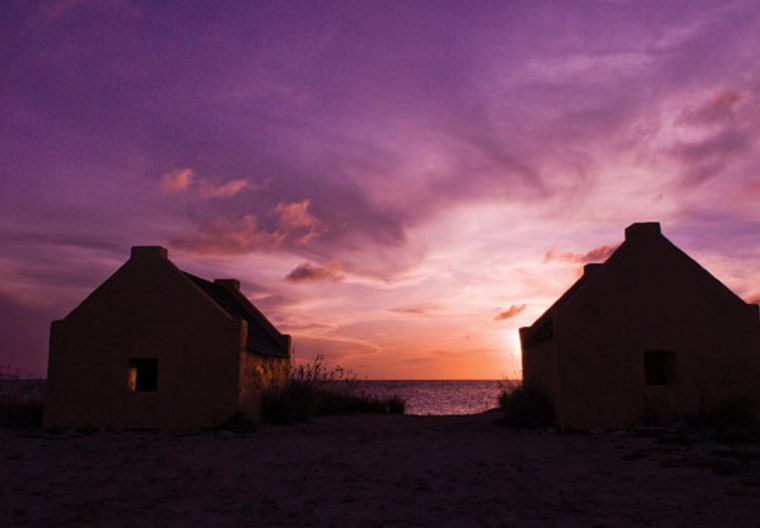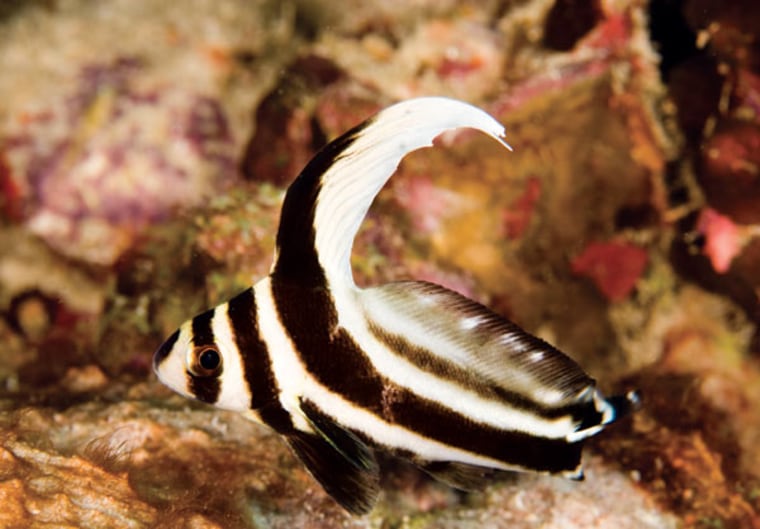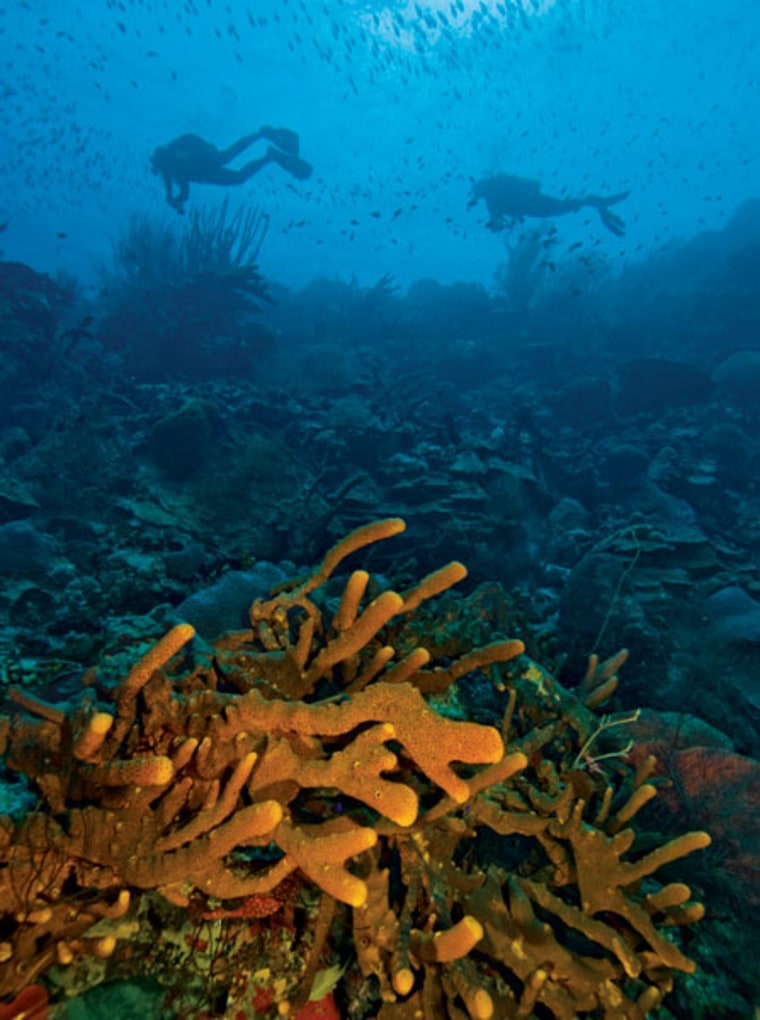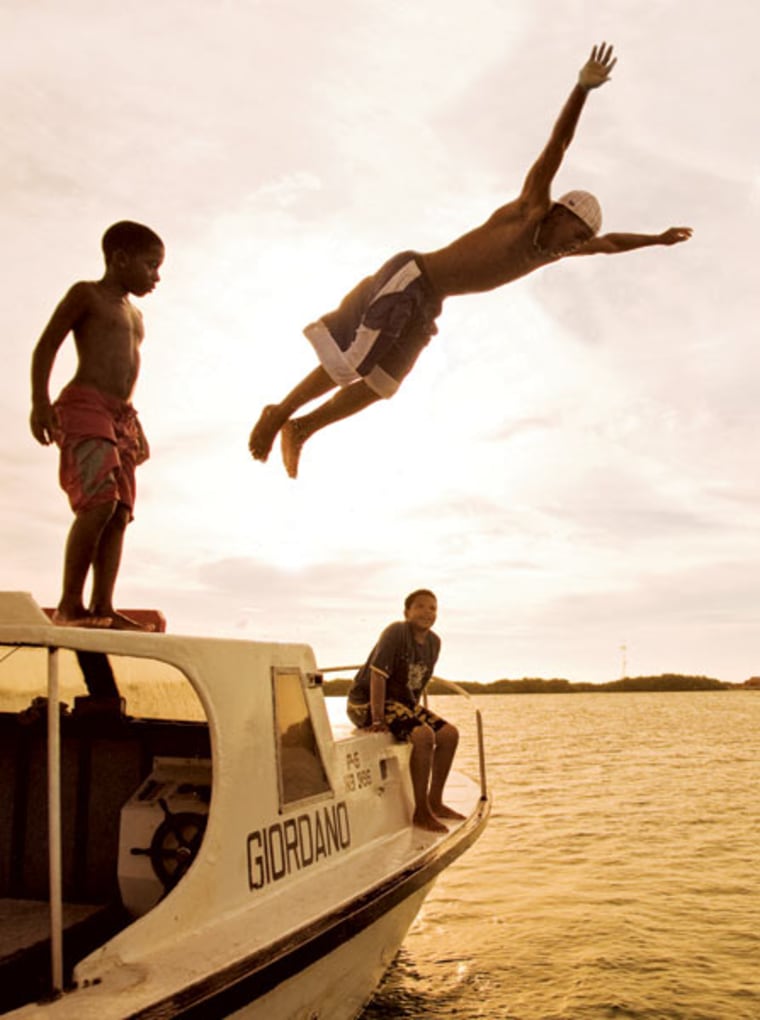It was a romantic October night on the pier at Buddy Dive Resort, a PADI Five-Star Gold Palm Resort in Bonaire. A hunter’s moon was up; the lights of nearby Kralendijk Harbor winked between the coconut palms; and the Caribbean Sea was a sultry 84 degrees. And a small crowd had already gathered around the schedule for the live sex shows that had just been posted next to the equipment rental office. It was a simple spreadsheet that listed the five acts and their starting times. Leave it to this little Dutch territory, I thought, to inject a bit of Hanseatic organization into the wild thing.
I’d come to Bonaire — a sliver of land shaped like a batfish dashing from the coast of Venezuela for the open Atlantic — to sample what was rumored to be a diver’s paradise. In fact, it says so right on their cute little yellow license plates: “Bonaire, N.A. — Divers Paradise.” Instead I’d stumbled into the greatest free-love event in the world.
I’m talking, of course, about the annual coral spawn. Twice every autumn when the tides and moon and water temperatures are stirred into the perfect aphrodisiac cocktail, the southern Caribbean Sea becomes one of the sexiest places on the planet as hard corals, soft corals, echinoderms, worms and even sponges let their exoskeletons down (no, not literally) and have a little fun.
And so, as the other divers made their plans, I glanced at my watch and ran a finger down the chart. It was just past 9 p.m. The large cup star corals were due to go on stage at 9:30. Perfect. I grabbed a tank, kitted up and duck-walked down the pier steps into water as black as any Amsterdam nightclub. I was back in an hour. Sadly — and despite their name — the star corals failed to perform. So I rinsed off my gear and headed back to my room, as frustrated as a West Point freshman.
They saved paradise
A crooning Joni Mitchell joined me the next morning after a restless sleep. The Caribbean was dull and flat and breakfast was hours off, so I decided to make a loop around the northern half of the island to try and spot some of the pink flamingos that outnumber the 12,000 Dutch and Papiamento-speaking locals. I hopped in the dual-cab Toyota pickup (the tank rack in back came standard) and clicked on the radio. Shortly after the outskirts of town gave way to an ironshore coast crusted with a 5 o’clock mesquite-brush shadow, I was singing along to Mitchell’s 1970 environmentally defeatist hit, “Big Yellow Taxi,” and pondering paradise.
“Don’t it always seem to go that you don’t know what you’ve got till it’s gone. They paved paradise and put up a parking lot …”
In Bonaire, I learned, they really did save, rather than pave, their paradise. Eight years before Mitchell sang about paradise lost in Hawaii, a 37-year-old California sea gypsy named Don Stewart dropped anchor off Bonaire and was inspired to pen a few lyrics in the log of his twin-masted schooner the Valerie Queen.
“Bay like glass, a spectrum of shimmering blues, extraordinarily clear. To the north a craggy silhouette of small mountains sloping southward to a flat spit of coral-rimmed beach,” he wrote. “Brilliant tropical fish of all varieties. Looks to be a fantastic underwater island.”
Conservation hadn’t come calling in the Caribbean yet; divers slung spearguns and snapped off elkhorn coral souvenirs. But Captain Don had fallen hard for Bonaire. He set up a dive resort — Captain Don’s Habitat — and began advocating reef protection. A serendipitous meeting with Dutch KLM executive Carel Steensma, an avid diver and a personal friend of His Royal Highness Prince Bernhard of the Netherlands, snowballed into the creation in 1979 of the Bonaire National Marine Park.

Today, all 6,671 acres of beach, reef and sand from the high-tide line to the 196-foot depth mark are completely protected. There are 86 official snorkeling and dive sites, virtually all accessible from shore. All but two fringe Bonaire’s west coast and surround the islet of Klein Bonaire, just half a kilometer west of Kralendijk.
Everybody who touches the water here pays the annual Nature Fee — $25 for divers, $10 for snorkelers and swimmers. Scuba divers are required to sit through an orientation class and do a checkout dive to make sure their buoyancy is under control. There are no gloves permitted. And spearguns? They’re not even allowed in the country.
Flamingos eluded me on my loop along the salt marshes and up through the cactus-crinkled hills of the Washington Slagbaai National Park, home to
790-foot Brandaris Hill, the highest point on the island. I did, however, encounter a couple of wild donkeys, feral descendants of the beasts of burden that once toiled in the sun-baked salt flats in the south. When I slowed down to take a photo, they trotted over, jammed their heads in the pickup cab and brayed, disappointed I didn’t have any food.
Hot and steamy
Back at the resort, I grabbed a quick burrito breakfast and joined the Kennedy Space Center Barracudas, a Florida dive club made up of rocket scientists — really — for a morning dive out at Klein Bonaire. We were headed to a site called Mi Dushi (Papiamento for “my sweetheart”).
We stepped into the blue within a sand-dollar skip of shore, and drifted down to the 26-foot mooring before fanning out over a series of terraced coral canyons. There was something odd about the sponges there, and as I glided down for a closer look I realized they were smoldering. A dozen aquatic forest fires were raging at 20 meters.
It took me a second to realize what was going on. I flashed back to the night before when I joined several other divers for a free REEF (Reef Environmental Education Foundation) talk in the cushy offices of Capture Photo, a photographic school at the Divi Flamingo Beach Resort & Casino. Resident fish expert Linda Ridley, a veteran of more than 1,000 fish-ID surveys, was explaining why we had picked — intentionally or not — the single best time to dive Bonaire.

“For most divers, a spawning is a once-in-a-lifetime event,” she said. “Do we know the exact time? No. The spawn starts up in Florida and moves down to the Caribbean. It’s triggered by a combination of factors from water temperature to the moon cycle.”
When the magic code is dialed in, said Linda, the coral and sponges release eggs and sperm into the water to drift with the currents.
“Synchronized mass spawning events allow stationary animals like corals and sponges to mix and disperse over great distances. They release millions and millions of egg packets or sperm, so much that predators just can’t eat it all.”
And, she said, it doesn’t all take place at night.
“Each species has its own timetable. You’ll see touch-me-not sponges and sea urchins spawning in the middle of the day.”
Which is exactly what I was seeing. The toxic touch-me-not sponges were billowing out clouds of sperm.
A chipmunk-cheeked porcupinefish shared my interest in the spewing sponges and so did a curious great barracuda. Divemaster Tina, however, waved me off. I thought she was just worried about me getting stung by the sponges. But it had to do with sexual hygiene, she informed me when we surfaced.
“You don’t want to get covered with sponge sperm,” she said with a straight face. “I’ve known people whose wetsuits stunk so much of fish they had to throw them away.”
I did not know that.
A shore thing
My days slipped away quickly between joining the Florida Barracudas as they ticked off almost all of Klein Bonaire’s dives and my so-far-unsuccessful evening search for sex on the reef.
Nights became my favorite time to dive. It wasn’t just the chance at witnessing the coral spawn. It was the sheer abundance of life. I was certain that given enough time, I could probably tick off every last one of Bonaire’s 355 fish species right there a few fin kicks from the dock in less than 10 meters of water.
There was the Caribbean octopus, which hung out near her hole beside the mooring. She flushed and pulsed and retreated into her fortress when I came to greet her. But when I settled down on the sand and played with her shell pile, invariably a slender leg unfurled, and she poked at a stray piece as if to say “checkmate.” There were the thigh-thick green morays that slid like loose Hulk muscles among the coral rubble, and the yellowline arrow crabs peeking back at me with their silver eyes from the midnight folds of a sponge.
And then there was Charlie.
Charlie was a hefty tarpon who took enormous pleasure in sneaking up behind me on midnight dives when my mind wandered to thoughts of bored tiger sharks coming in for a shallow look-see even though I hadn’t seen as much as a nurse shark on all my dives. And suddenly there was Charlie in a bangled tin explosion that left me hyperventilating.
I got off easy. Usually when the sand cleared, some poor fish I’d caught in my flashlight beam and was preparing to identify was nothing more than a glittery rain of scales. The only ID I could give them was ‘edible.’

It took effort to break away from the gravity of the easy Klein Bonaire boat dives. I had to remind myself that I had a tough set of wheels and a nifty book titled Bonaire Shore Diving Made Easy, by Susan Porter.
With the two most famous dives — the Salt Pier and the Town Pier — closed to diving for the duration of my visit (ships were docked at both), I hit the drive-through and struck south along the windswept southern wing of the island with a pair of Brits who had invited me to tag along. A quarter hour after passing Kralendijk, they pulled off the shoulder and into a small stony parking lot beside a highway-stripe-yellow stone with an arrow and “Alice in Wonderland” painted on it.
Booties on and fins in hand — this is not an island for full-foot fins — we waded over the coral rubble and sand pockets into the rippled surf until it was deep enough to snorkel out to the mooring. Passing over a sandy meadow full of swaying garden eels and knobbed with the odd queen conch, we dropped along the outside edge of the double reef to 140 feet where stony plate corals were basking in sunlight so bright I needed a pair of Ray-Bans. Farther out off the sloped wall, hatchet-thin horse-eye jacks whirled, and the ghost of a turtle faded away.
Our nitrox tanks seemed to last forever because we barely moved, preferring to drift in a whisper of a current and watch the denizens of paradise at play. When we finally slogged out and rolled our tanks into the pickups, I asked my companions how many times they’d dived Wonderland.
“Oh, we’ve done Alice at least six times,” they replied, nodding in agreement.
“Over how many trips?”
“That’s just this trip,” and then they started counting up how many times they dived it on previous trips.
In Bonaire, apparently, there’s no such thing as too much of a good time.
After toweling off, I said goodbye and ventured farther south along the flat barren land to marvel at a perfect range of snowy hills. The southern tip of Bonaire still produces white gold in evaporative ponds run by Cargill Salt. Nearby was a row of restored slave huts built in 1850 to give shelter to the unfortunate souls working the briny pans. I wedged myself into one to see what the flip side of paradise looked like. The scalding wind moaned and the friendly, easy Bonaire I knew evaporated in the heat.
Where the road reached its southernmost point and began to climb up the wilder east coast, I stopped to admire the Willemstoren Lighthouse and the creaking Wind Trykes — contemporary windmills that pump water around the vast solar works. A handful of pink flamingos that overslept their daily flights to feed in Venezuela were skimming the waters of the Flamingo Sanctuary with scooped bills. On the roadside facing the open sea, tourists had created their own Bonaire versions of the The Blair Witch Project, eerie driftwood scarecrows that seemed to howl in the wind.
My diving was done for the afternoon, so instead of returning the way I came, I decided to make a circuit of the south and take the long way home. I rumbled along narrow E.E.G. Boulevard farther north and east where the windy, open salt pans hastily retreated to an army of gnarled mangroves marching like wooden spiders to the very edge of the road. The land was wetter here, and I passed a red triangular warning sign: “Drijfzand” (quicksand).
The road eventually wound along Lac Bay, a tranquil bite of a lagoon on the otherwise wave-thundered coast. Windsurfers took advantage of the sanctuary and skimmed the glassy water. Nearby, children had turned the Lac Bay harbor into the best swimming pool I’d ever seen; the high-dive was the roof of a fiberglass fishing boat. In the parking lot a party was underway and I was drawn in by happy shouts of “Bon tarde!” All too soon the sentimental evening light faded and stars crept above the mangroves, and it was time for me to make my way back.
Getting lucky
My new schedule of roaming around the island in a pickup truck freed up the entire west coast to me, and soon I was ticking off dive sites until they began to blend together. I needed a break. I needed an evening to clear my head and off-gas. It was Friday, so I headed to town, the seemingly unpronounceable, unspellable and completely delightful burg of Kralendijk.
For the island’s largest town, Kralendijk still leans easy on the quaint side. The West Indies meets Holland along the waterfront where pink and gold buildings trimmed in white peak in high Dutch gables. I wandered along the pier at sunset where the happy murmur of open-air bars and the mournful cry of a mariachi band mingled in the evening air. While dinghies from the nearby yachts puttered in for happy hour and the guitar-strumming bandits sang “Bésame Mucho,” I grabbed a stool at Karel’s Beach Bar and ordered the house special — a green-bottle Heine-ken. Together with a young Elvis gazing down from a black-and-white photograph above the bar, I watched Bonaire unwind for the weekend.
A wind had picked up the next morning, and the sandy south-side dive sites were getting hazy with surge, so I headed to the north end of the island. There, the ironshore coast drops straight into the sea; with no sand to get stirred up, I could still count on great visibility.
I wasn’t disappointed. When I hopped off the 4-foot-high limestone rim at Oil Slick Leap and the bubbles cleared, I was back in the sparkling blue. This time, I’d brought along my laminated Reef Fish In-A-Pocket and Reef Creature In-A-Pocket guidebooks with the hopes of putting some of my knowledge gained at Linda’s REEF fish-ID course into use.
Chubs and mojarras, grunts and snappers, chromis and groupers were duly sorted into species. Parrotfish and soldierfish, basslets and wrasse were cataloged with confidence. I hung suspended at 45 feet barely moving, thumbing through the pages. I ran out of air long before I ran out of species.
Later that night back at the resort’s dive shop, I saw the familiar, hopeful crowd outside the equipment-rental office, huddled over the spawning chart. I was tired, but the water was right there. My gear was right there. The schedule was right there. It was all so easy. I headed out for one last night dive. And this time, I decided, instead of using the shotgun approach, I was going to find a single star coral head and stake it out.
Charlie showed up and rattled me, but quickly departed for a nearby couple. I saw the explosion of bubbles from their regulators a second later in the glow of their flashlights. I could almost hear their screams and Charlie’s wicked snicker.
I found a promising star coral and settled down to wait. Ten minutes ticked by. Then 15. And then it happened. First one pale little polyp erupted and then another tickled out of the wavy folds and floated away.
Suddenly, it looked like what happened when Baffin, my black lab, decided to dissect my bean bag chair — the coral head was bursting with white pellets. Out of nowhere, the normally reclusive brittle stars arrived, feathered tentacles lashing this way and that, scooping up egg packets like they were dollar bills in a wind tunnel on some late-night game show. The brittle stars were overwhelmed with gluttony and I watched one forget he still needed to hang on with at least one tentacle. He tumbled off the coral, arms tightly wrapped around his treasures. But I bet he was happy.
I had the show all to myself and lay there on the sand for a half hour until deep within the spent coral head the spigot turned and the next generation was left to the fate of the currents.
Back at the dock, divers emerged like wet seals, abuzz. Did you see it? Did you miss it? I was one of the lucky ones. But I shouldn’t have been too surprised. After all, I’m in a diver’s paradise. And in paradise, even a guy like me gets lucky once in a lifetime.
Special thanks to Buddy Dive Resort (buddydive.com), Budget Car Rental (bonaire-budgetcar.com), Capture Photo (capturecaribbean.com), Caribbean Club Bonaire (caribbeanclubbonaire.com), Chile & Linda Ridley of REEF (reef.org), Dan Blodget at Sub Aquatic Camera (subaquaticcamera.com), Divi Flamingo Beach Resort & Casino (diviresorts.com), Rolando Martin of Tourism Corporation Bonaire (infobonaire.com), Sarah Biggerstaff of Adams Unlimited Public Relations and Marketing (adamspr.com) and Tourism Corporation Bonaire (infobonaire.com).
Deco stops
Some evening, stop off for a fresh wahoo pizza and a slice of frozen margarita pie to go from Pasa Bon Pizza & Bar just north of Kralendijk, and head south to watch the sunset at the 19th-century slave huts, a stark reminder of how Bonaire’s white gold was mined — crawl inside one and try to stretch out. Just across the street in the open marshes is the Flamingo Sanctuary where you can see flamingos in the morning and at dusk (but stay on the road; the sanctuary is closed to humans). Decompress on your last day at the Lac Bay mangrove forest, four miles southeast of Kralendijk. The Mangrove Info Center Bonaire offers one- and two-hour guided kayak tours through this aquatic maze for $25 for a one-hour tour or $43 for a two-hour tour.
The guide to Bonaire
Average water temperature: summer 84°F; winter can drop into the upper 70s
What to wear: 3-5 mm suit; forgo pocket fins for booties (almost all the dives are shore dives from rugged ironshore or stony beaches)
Average visibility: 100-plus feet
When to go: The diving is good year-round; November to January is the wet season.
Must do
Rent a car and drive to the very northern tip of the island to visit Washington Slagbaai National Park, where the land wrinkles up into dusty, cactus-spiked hills and flamingos can be seen wading the briny pools (bring the receipt from your Bonaire National Marine Park pass). Bring along a mountain bike (Buddy Dive Resort rents them for $10 a half day or $15 for a full day) and patrol the narrow dirt roads winding through the park. Keep your eyes peeled for wild donkeys and the endangered prikichi — a Caribbean parakeet — one of 130 avian species that reside here.
Must dive
Hilma Hooker: This 236-foot cargo freighter was sunk for divers in 1984 and has become a brilliantly colored canvas for reef life. While it is accessible from shore, this dive is most easily done by boat.
Oil Slick Leap: Enter this site with a 5-foot giant-stride off the ironshore to the right of a wooden deck (where your only exit, a ladder, is located). The mooring is in 28 feet of water, and it’s an easy dive with lots of pretty gorgonians — a great spot to learn fish species.
Monte’s Divi, Klein Bonaire: Just off the mainland, this dive offers the best of Klein Bonaire with plenty of fish and sponges.
Salt Pier: Probably the most famous dive on Bonaire, for good reason. The pillars supporting the pier are dressed in fantastic sponges and are home to all sorts of fish and invertebrates; night dives here are particularly rewarding. Your dive outfit will be able to arrange for the required permission and dive guide. (Diving is prohibited when ships are docked.)
Rigged & ready
SCUBAPRO 5 mm Molded Sole Boots: Lightweight and flexible, these booties are suitable for various settings, including shore diving. scubapro.com
SeaLife Digital Pro Flash: This flash (shown with SeaLife DC600 Digital Camera) helps capture underwatersplendor. sealife-cameras.com
